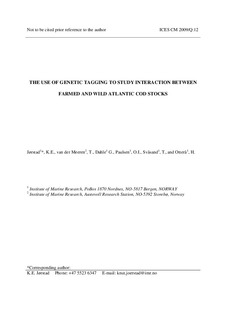| dc.description.abstract | Escapement of farmed fish from the aquaculture is considered as a risk for negative genetic
impacts on native gene pools. In order to investigate potential interbreeding between cultured
and wild Atlantic cod, Gadus morhua L, a genetically marked cod strain was developed.
These fish are homozygote for a rare allele in one of the glucosephosphate isomerase locus
(GPI-1*30) expressed in white muscle tissue. Offspring from this strain were first used in
large scale enhancement experiments at three locations in western Norway (1990 – 1994). As
expected, the releases were followed by a significant increase of the overall frequencies of the
marker allele in all locations, but the frequency declined rapidly thereafter. After about 10
years, however, significant higher frequency was only detected in one region, suggesting
survival to maturation and some reproduction success of the released cod. Mature cod
possessing the marker allele were collected from this region as basic for establishing a new
farmed genetic tagged strain of cod. This strain was allowed to spawn in net pens in 2006 and
2007, and successful spawning was documented as well as leakage of fertilized farmed eggs
and larvae into the natural environment. The survival and geographical spreading of the
farmed offspring have been investigated, and recently, genetically marked fish of similar size
as mature wild cod in the local area was observed. In addition, a new industrial scale study
has been initiated based on the same cod strain. To year-classes (2007 and 2008), each
consisting of 500 000 juveniles, are now farmed in a commercial cod facility. A
comprehensive monitoring program has been established to detect escapees during the
farming period. The first escapes, identified through the genetic tag, were found in the fjord
area in November 2008, and a larger escapement was detected in early April 2009. A fraction
of these fish were mature and offspring was detected throughout the 30 km long fjord system,
including on local spawning sites of the wild cod. | no_NO |
